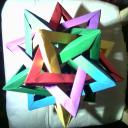
 Here are a few (unfortunately low-quality shots) of a modular origami implementation of five interlocking tetrahedra. This model uses Thomas Hull’s design. The joins are a bit sloppy, but it holds together nicely.
Here are a few (unfortunately low-quality shots) of a modular origami implementation of five interlocking tetrahedra. This model uses Thomas Hull’s design. The joins are a bit sloppy, but it holds together nicely.
Modular origami is quite relaxing, very much like knitting. Once you have mastered a basic pattern, you can just disengange your brain and let your hands do the work. For larger constructions, in fact, it is extremely important to have something else distracting you from what might otherwise become intolerable tedium. Then, after you’ve constructed all your modules, comes the fun part: stitching everything together into the finished shape. This design, in particular, is a bit of a brainteaser; you have to carefully puzzle out where each strut goes, under or over. The final result is satisfyingly impressive.
7 replies on “Five Interlocking Tetrahedra”
[…] Math-Art is by Paul over at zenoli. He used Thomas Hull’s design to make this interlocking tetrahedra (a tetrahedra is a […]
I was so impressed by your origami interlocking tetrahedra I would like to make one using 12mm square timber.Are you clever enough (flatter,flatter) to work out the minimum length of each tetra.so that they interlace without cutting into each other.
Thanking you .B.S.
Brian,
An advance warning: this is totally back-of-the-envelope scribbling, so no guarantees.
Consider the origami struts. As three come together at each point, they should be folded at 60 degrees…the cross-section is, effectively, an equilateral triangle with open side. A strut is folded from a piece of paper with original proportions of 1:3; after folding, each face will be 0.25 of that ‘1’, so the ratio to the length will be, then, 1:12. So, how far is it from the fold to the center of the open side? Calculating the height of an equilateral triangle gives us 1 * 0.5 * sqrt(3) ~~ 0.86. So, the ratio of that distance to the length of the strut will be something along the lines of 1:13.95 ~~ 1:14.
Assume, for sake of argument, that you’re fitting your struts together with an edge (rather than a face) along each edge of each tetrahedron. The diagonal cross-section of a strut will be 12mm * sqrt(2) ~~ 16.97mm ~~ 17mm. This might lead us to conclude that a good strut length might be 238mm. On the other hand, if you’re fitting the struts with a face along each tetrahedral edge, 168mm might work.
There are a lot of probably faulty assumptions (not to mention dodgy math and worse geometry) in there, and when combined with the differences in tolerance between wood and paper….I’d recommend cutting your pieces long and sticking them together with putty at the ends while you’re fitting things together…trimming would be a much better prospect than gluing.
Please let me know how it turns out (and what strut length turned out to be correct).
Paul,
Thanks for your speedy reply.My results will take a lot longer,and there may be more quaestion before completion.
I`ll keep you informed. Thanks again,Brian.
Hi paul … what you have did is amazing .. do you have a step by step instruction on how u accomplish the feat?
Andrei: As mentioned in the article, this construction uses a design by Thomas Hull, and folding instructions can be found on his website (http://kahuna.merrimack.edu/~thull/fit.html). The modules for the struts are quite easy to fold, though the model won’t hold together quite as well if they’re sloppy. It’s simple to interlock three tetrahedra and fairly straightforward to interlock four, but it’ll probably take a bit of puzzling to figure out which struts go where when you add the fifth. Good luck and have fun!
yes, the fifth if very puzzling… and frustrating. Definately an exercise in patience. I’m disappointed that the paper bends in some places in the one that I have assembled. I am trying it again, but with a different kind of paper.